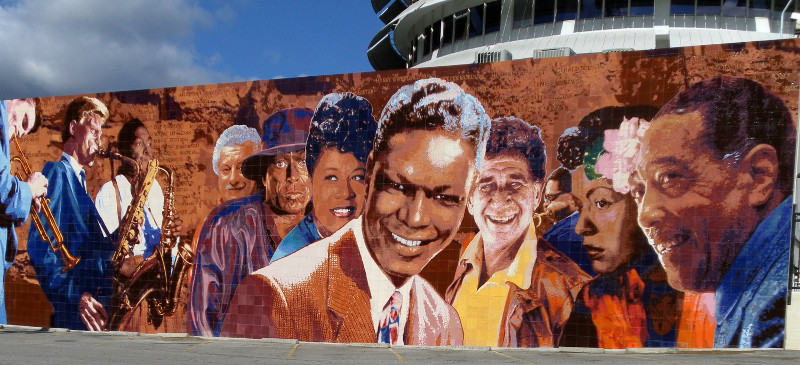
Precious little in Hollywood outwardly signifies its glorious jazz history and circumscribed jazz present. Catalina Bar & Grill, the last remaining Hollywood jazz club, isn’t even visible from Sunset Boulevard. The Hollywood Bowl, site of the Playboy Jazz Festival and a summer series, hosts all kinds of music, not just jazz.
Since 1990, though, Capitol Records, at 1750 Vine Street, has been the site of a major jazz icon. That’s when artist Richard Wyatt Jr. completed his “Jazz in Hollywood, 1945-1972” mural on the south wall of the iconic tower. It depicts Duke Ellington, Billie Holiday, Nat ‘King’ Cole, Ella Fitzgerald, Dizzy Gillespie, Charlie Parker, Miles Davis, Chet Baker, Shelly Manne, Gerry Mulligan and Tito Puente. The outdoor painting (22 feet high and 88 feet long) has become a symbol for Tinseltown’s jazz lineage, appearing in countless movies, TV shows and videos.
The late jazz activist Teri Merrill-Aarons, whose fledgling Los Angeles Jazz Society had only sponsored tribute concerts up to that point, sought out Wyatt. He was a conspicuous public artist, on his way to becoming the most prolific and high profile Southern California muralist. A select committee settled on the musicians to be represented and Wyatt came up with a design that was quickly approved. Joe Smith headed Capitol at the time and was extremely cooperative. “I’d had my eye on that wall for a long time,” says Wyatt, from his home in L.A.
Over many months, on a four-story scaffold, Wyatt painted, with help from his father, Richard Sr. He recalls a special moment: “I was working on Gerry Mulligan,” he relates, “listening to him on my Walkman, and he pulled up in the parking lot! He stopped to talk, and loved what he saw. He wrote me a very nice letter later on.”
All SoCal murals are subject to brutal sun exposure. Years of weather damage robbed the painting of its outer finish. While Wyatt wanted to restore it for some time, changing Capitol regimes showed varying degrees of interest. Sympathetic executives finally gave him a green light.
On subsequent projects, such as the Union Station bus terminal and Robert F. Kennedy High School, Wyatt changed to painting his large-scale pieces onto glazed ceramic tiles. “It’s more permanent that way,” he points out.
The immensity of the Capitol piece offered big challenges to a tile re-configuring. Wyatt’s friend, artist George Evans, teaches computer graphic design. “I worked with him to digitize the image,” Evans offers. “Using his original drawings and photos, we scaled the image and put it on a grid. Then I scanned it so that every tile would be correctly proportioned and contain all the information.”
Still, all of that visual data had to be transferred onto the tile. Evans enlisted two former students: artist/designers Rudy Mendez and Jose Ramirez. “Jose had a new machine,” Evans recounts, “he said could transfer an image onto anything.” Wyatt adds: “We did some experiments with tile and found that it could pick up images from a digital file beautifully. So the teacher,” he adds, grinning, “became the student.”
Wyatt Sr. conducted the painstaking process of firing the tiles (each piece took two days in the kiln), with help from a dozen students that Mendez had gathered. A professional crew did the installation and, after over a year’s time, the original luster of the Capitol jazz mural was restored.
“Over the years,” Wyatt Jr. marvels, “I’ve met people like Les McCann, Buddy Collette, Horace Silver, and many others who all knew that mural: ‘Oh—you did that!’ Maria Cole, Nat’s widow, loved the study when she saw it but asked that I paint his favorite tie into it. No problem! It’s great to be able to touch that kind of history.”
